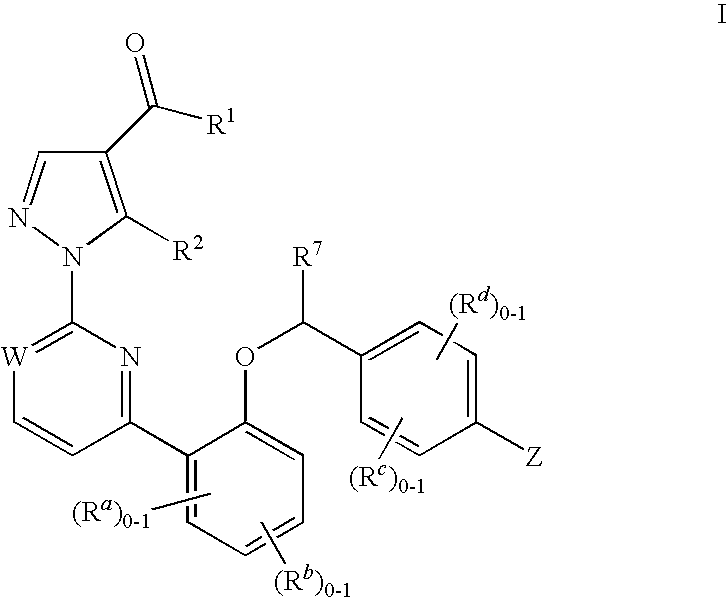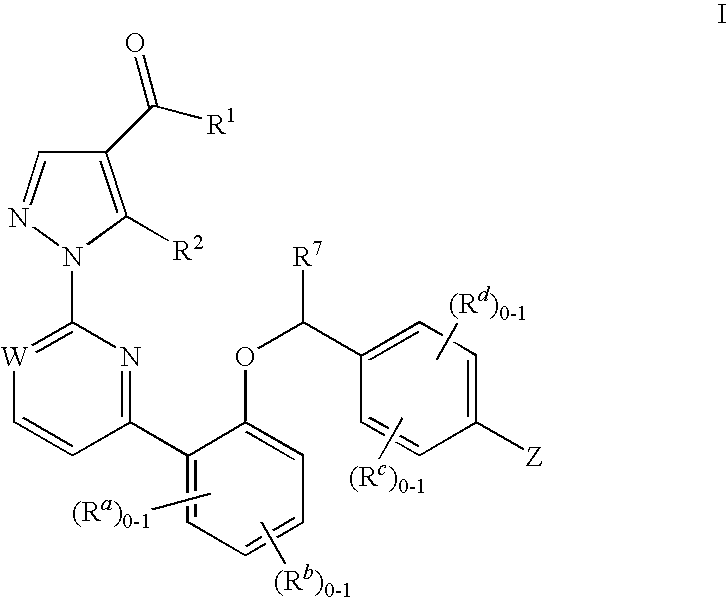Soluble guanylate cyclase activators
a guanylate cyclase and activator technology, applied in the field of soluble guanylate cyclase activators, can solve the problems of increased dosage, increased tolerance, and reduced activity of poisons, and achieves the effect of only weakening the formation of cgmp, and reducing the number of toxic substances
- Summary
- Abstract
- Description
- Claims
- Application Information
AI Technical Summary
Benefits of technology
Problems solved by technology
Method used
Image
Examples
example 1
[0141]
Step A. tert-Butyl 4-(4-(ethoxycarbonyl)phenyl)-3,6-dihydropyridine-1(2H)-carboxylate
[0142]Preparation of 1,1-dimethylethyl 4-(((trifluoromethyl)sulfonyl)oxy)-3,6-dihydropyridine-1(2H)-carboxylate: To a cooled (−78° C.) solution of 1-Boc-4-piperidinone (30.22 g, 152 mmol) in THF (200 mL), was added LHMDS (174 mL, 1.0 M in THF, 174 mmol) dropwise over 40 min. After 2 h, a solution of 2-[N,N-bis(trifluoromethylsulfonyl)amino]-5-chloropyridine (61.3 g, 156 mmol) in THF (100 mL) was added dropwise via cannula over 30 min. The cooling bath was allowed to warm slowly to ambient temperature over 15 h, at which point the reaction mixture was concentrated in vacuo. Purification by silica gel chromatography (0 to 15% EtOAc in hexanes, then 15 to 100% EtOAc in hexanes; TLC plates visualized using potassium permanganate stain) provided the enol triflate: 1H NMR (500 MHz, CDCl3) δ 5.77 (br m, 1H), 4.05 (br m, 2H), 3.63 (br m, 2H), 2.44 (br m, 2H), 1.48 (s, 9H).
[0143]Preparation of tert-But...
example 2
[0152]
Step A. Ethyl 1-(6-(5-fluoro-2-methoxyphenyl)pyridin-2-yl)-5-(trifluoromethyl)-1H-pyrazole-4-carboxylate
[0153]To a flask containing the title compound from the Example 1 Step D (2.50 g, 7.82 mmol) were added 2-methoxy-5-fluoro-phenylboronic acid (1.595 g, 9.38 mmol) and trans-dichlorobis(triphenylphosphine)palladium (II) (548 mg, 0.782 mmol). Acetonitrile (25 mL) and sodium carbonate (19.6 mL, 1.0 M aqueous, 19.6 mmol) were added, and the resulting mixture was degassed via nitrogen sparge. The reaction mixture was stirred at 70° C. for 4 h, then was allowed to cool to ambient temperature and was poured into water. The mixture was extracted with EtOAc, and the organic phase was concentrated in vacuo. Purification by chromatography on silica gel (0 to 35% EtOAc in hexanes, then 35 to 100% EtOAc in hexanes) provided the title compound: LCMS m / z 409.9 [M+H]+; 1H NMR (500 MHz, CDCl3) δ 8.16 (d, J=8.0 Hz, 1H), 8.12 (s, 1H), 7.94 (t, J=8.0 Hz, 1H), 7.73 (dd, J=9.5, 3.0 Hz, 1H), 7.58 ...
example 3
[0158]
Step A. Methyl 2-methyl-4-(4,4,5,5-tetramethyl-1,3,2-dioxaborolan-2-yl)benzoate
[0159]A round bottomed flask was charged with methyl 4-bromo-2-methylbenzoate (3.98 g, 17.37 mmol), bis(pinacolato)diboron (4.85 g, 19.11 mmol), potassium acetate (5.12 g, 52.1 mmol), and dichloro [1,1′-bis(diphenylphosphino) ferrocene] palladium (II) dichloromethane adduct (0.426 g, 0.521 mmol). The flask was purged with nitrogen. Anhydrous DMSO (100 mL) was added, and the resulting suspension was degassed via nitrogen sparge. The mixture was then placed in a pre-heated oil bath (80° C.), and was held at this temperature for 2 h, whereupon it was allowed to cool to ambient temperature, then was poured into water. The aqueous phase was extracted with ether, and the organic phase was washed with brine. The organic phase was then separated, dried over anhydrous sodium sulfate, filtered, and concentrated in vacuo. Purification by flash chromatography on silica gel (0 to 10% EtOAc in hexanes, then 10 to...
PUM
| Property | Measurement | Unit |
|---|---|---|
| weight | aaaaa | aaaaa |
| weight | aaaaa | aaaaa |
| flow rate | aaaaa | aaaaa |
Abstract
Description
Claims
Application Information
 Login to View More
Login to View More - R&D
- Intellectual Property
- Life Sciences
- Materials
- Tech Scout
- Unparalleled Data Quality
- Higher Quality Content
- 60% Fewer Hallucinations
Browse by: Latest US Patents, China's latest patents, Technical Efficacy Thesaurus, Application Domain, Technology Topic, Popular Technical Reports.
© 2025 PatSnap. All rights reserved.Legal|Privacy policy|Modern Slavery Act Transparency Statement|Sitemap|About US| Contact US: help@patsnap.com



